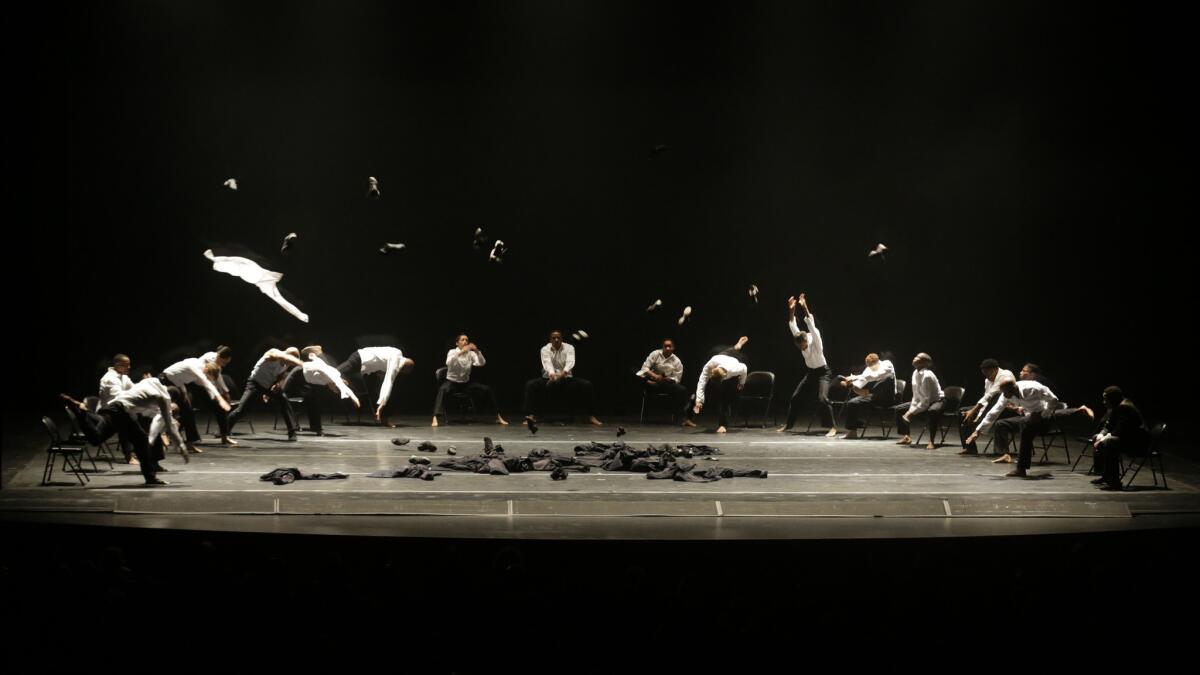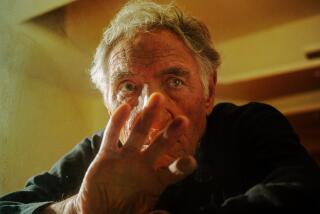Review: Alvin Ailey at Dorothy Chandler: Brutality chic in modern dance

Alvin Ailey dancers perform Ohad Naharin’s “Minus 16” Wednesday at the Dorothy Chandler Pavilion in Los Angeles.
From its first performances in 1958, the Alvin Ailey American Dance Theater has championed overlapping social and creative agendas. Not all of them were evident in the four-part “Power of Ailey” program Wednesday at the Dorothy Chandler Pavilion, but just enough remained to understand the words used by artistic director Robert Battle in his welcoming speech about “artistry as a weapon for change.”
Essentially an excursion into male-dominated brutality chic, the Wednesday “Power” repertory featured harsh lighting, assaultive sound scores and bold athleticism, with the dancers working so hard for full-out intensity that ideal control wasn’t always achieved. (The engagement continues through Sunday with three different programs in rotation.)
The only vehicle to showcase the company women, Ulysses Dove’s 1987 “Episodes,” began with Yannick Lebrun and Jamar Roberts hurling themselves onto the stage to percussive rhythms composed by Robert Ruggieri. Indeed, hurling continued as a key component of this pitiless portrait of failed or, at best, fleeting relationships. With the men constantly using and abusing their partners and the women seeking to connect and sometimes entice, the work evolved into an action-painting of empty urban couplings, the nine participants alternately rooted and restless, sometimes breaking out into flurries of almost desperate, look-at-me display, but essentially going nowhere.
Although Sarah Daley occasionally supplied balletic counterpoint, the movement mostly remained weighty, forceful and deliberately cold -- though while it lasted, the mating dance for Roberts and Akua Noni Parker generated a distinctive frost burn.
Nineteen years after “Episodes,” Hofesh Shechter’s “Uprising” looked at male bonding with the same clinical detachment, using more pounding rhythms by himself and Vex’d. Friendship here continually morphed into competition -- a pat into a punch, a game into combat -- and any dependency proved a sign of weakness. Occasionally the seven men standing aimlessly in groups seemed a neo-documentary portrait of urban street-gangs, though elsewhere Shechter evoked sports teams, especially at the end when Marcus Jarrell Willis (who earlier had a hot twitching solo) raised the flag of victory over a ceremonial body pileup.
Tests of strength, rites of passage, corrosive machismo -- Shechter didn’t miss much, though, occasionally, as the men reached up into an empty sky or stood helpless under the sonic bombardment of torrential rain, glints of compassion varied this picture of directionless male energy.
Although lighting design and the use of darkness made important contributions to all the works, Lee Curran’s contribution to “Uprising” became a dominant force, ranging from an upstage bank of lights to piercing shafts from overhead and even a kind of haze-curtain for the men to disappear into.
The dancer effectively controlled the lighting in David Parsons’ familiar 1982 solo “Caught,” setting off strobe-flashes that isolated him posing or jumping. The piece depends upon what’s known as persistence of vision, the human faculty that connects isolated images in a sequential flow and makes 24 frames of motion-picture film add up in our minds to a second of realistic motion. On Wednesday, Kirven Douthit-Boyd set off the flashes at the height of his jumps and, in our minds, he appeared to float in space, soaring freely and effortlessly.
Music by Robert Fripp supplemented the illusion, and, as usual, “Caught” brought the audience to its feet. But other performers have found a unifying theme -- an earthbound creature’s dream of flight. But the movement alone had to suffice on Wednesday.
“Caught” may be a brilliant card-trick of a dance, but Ohad Naharin’s 1999 ”Minus 16” trumps it with a fakeout at the beginning (a wild improvisational solo by Samuel Lee Roberts), an ironic ballet-class finale and an audience participation section in which a dozen or more dancers recruit audience members to join them on the stage for a “Hooray for Hollywood” cha-cha and an irresistibly sultry ballroom-style “Sway.”
What’s more, Naharin’s sense of fun and games extends to the formal choreography on view: 19 dancers (men and women) in business suits seated in a circle of chairs flinging themselves through a sensational movement cycle. Think of “Old MacDonald Had a Farm” and how each repetition of the verse features an additional animal noise -- in this case, an additional movement phrase -- and you can see how the cycle became a bravura unison display leading to the discarding of hats, shoes, jackets, shirts and trousers.
Eventually the chairs vanished to make room for more conventional modern dance, including an eccentric gymnastic duet for Douthit-Boyd and Ghrai DeVore. But nobody won more hearts than audience draftee Ellin Palmer, an elegant lady in red kept front and center in that “Sway” ensemble -- with her own follow-spot, no less.
“The Power of Ailey” repeats on Saturday, and maybe you’ll be in the spotlight at that performance. But don’t count on it. The search for fame can be cruel in this town. Better keep your day job.
“Power of Ailey,” Alvin Ailey American Dance Theater, Dorothy Chandler Pavilion, 135 N. Grand Ave., Los Angeles. 7:30 p.m. Friday, 2 and 7:30 p.m. Saturday, 2 p.m. Sunday. $27-$159. (213) 972-7211, www.musiccenter.org.
More to Read
The biggest entertainment stories
Get our big stories about Hollywood, film, television, music, arts, culture and more right in your inbox as soon as they publish.
You may occasionally receive promotional content from the Los Angeles Times.










